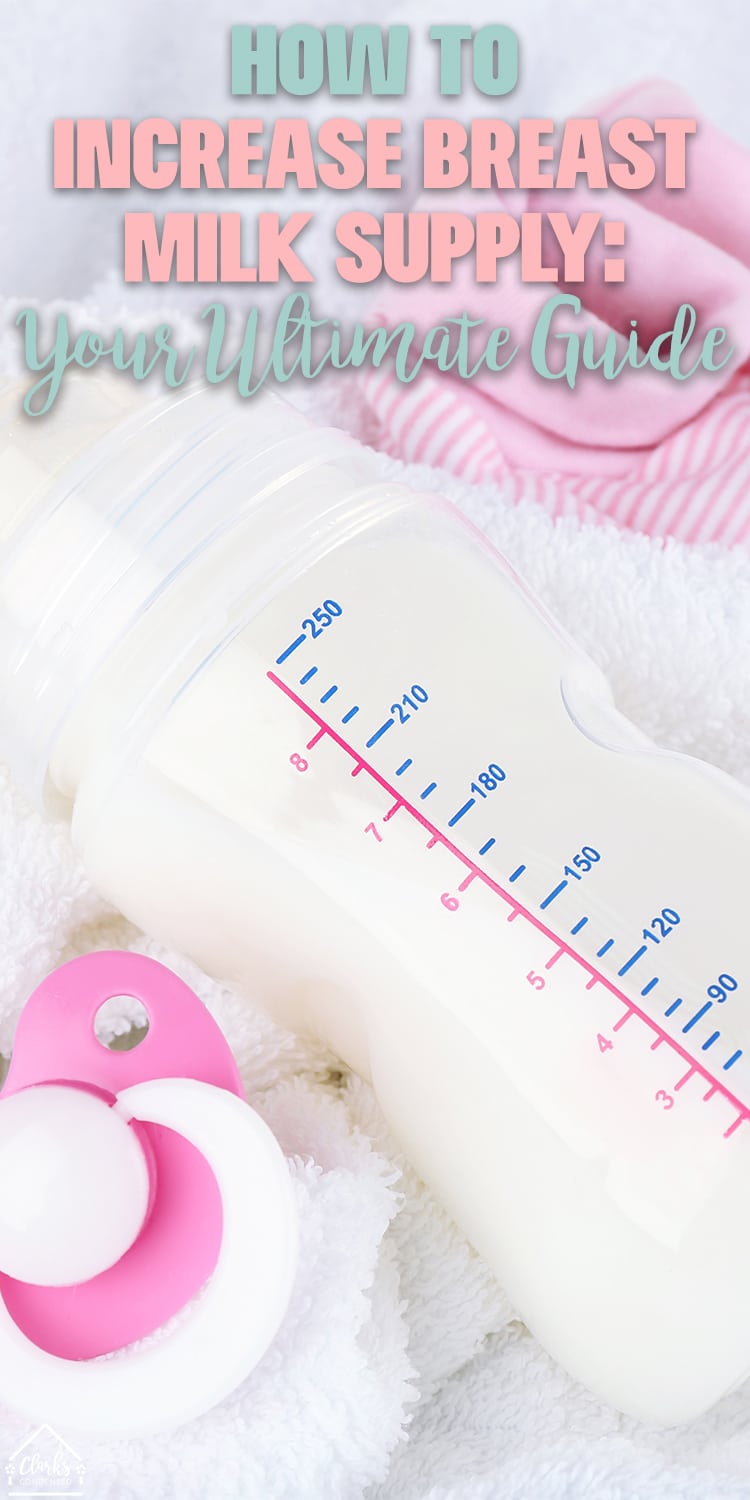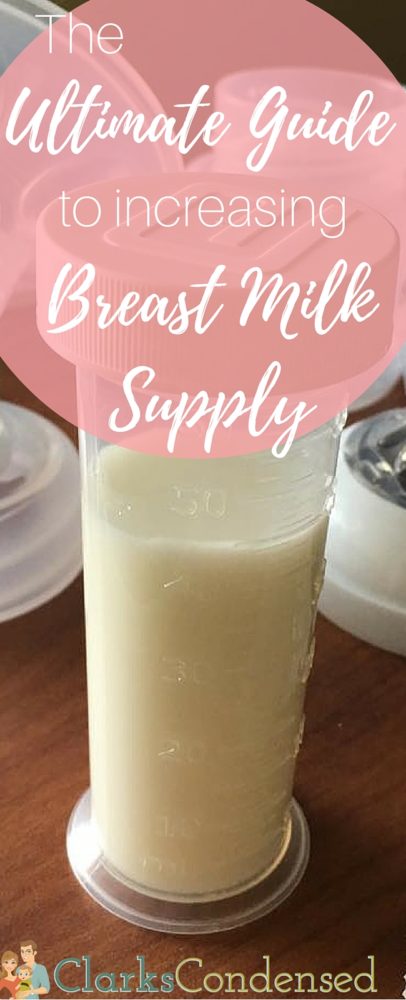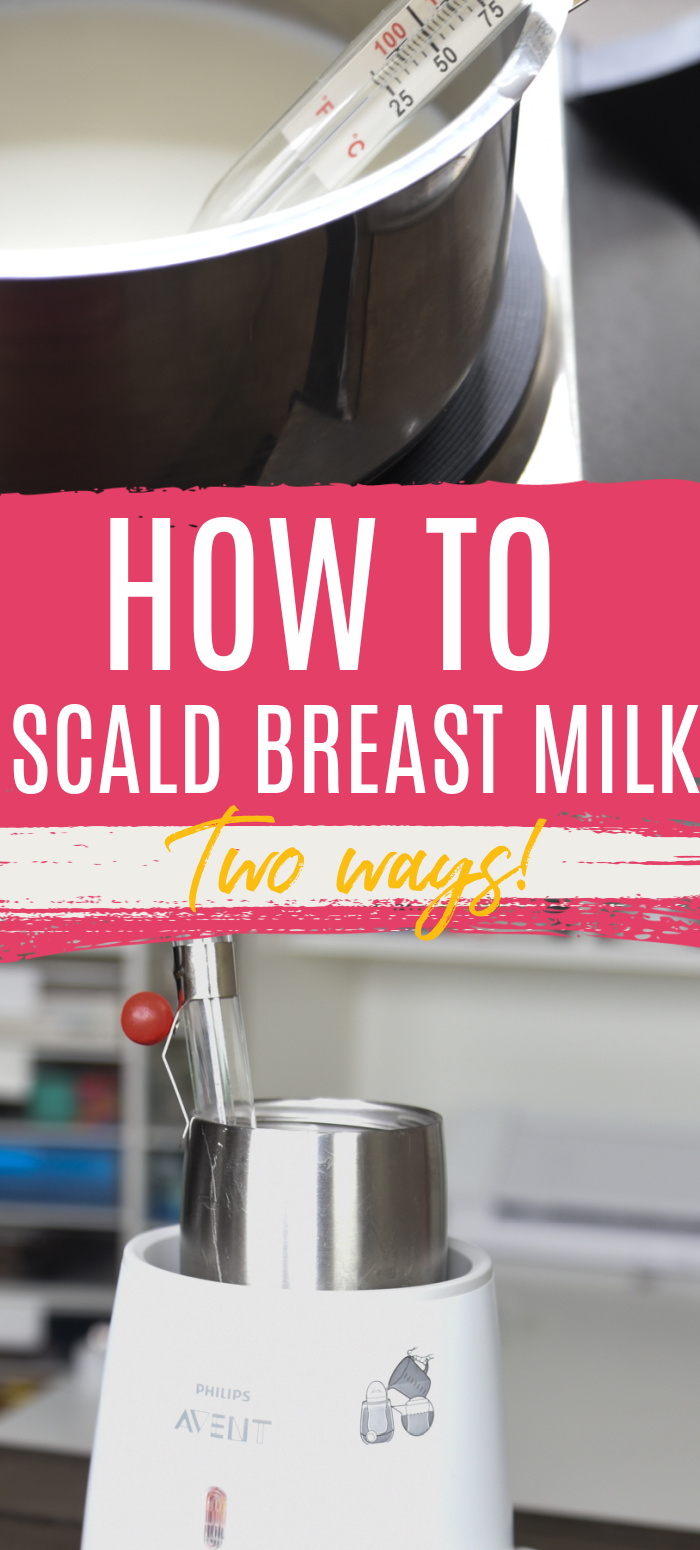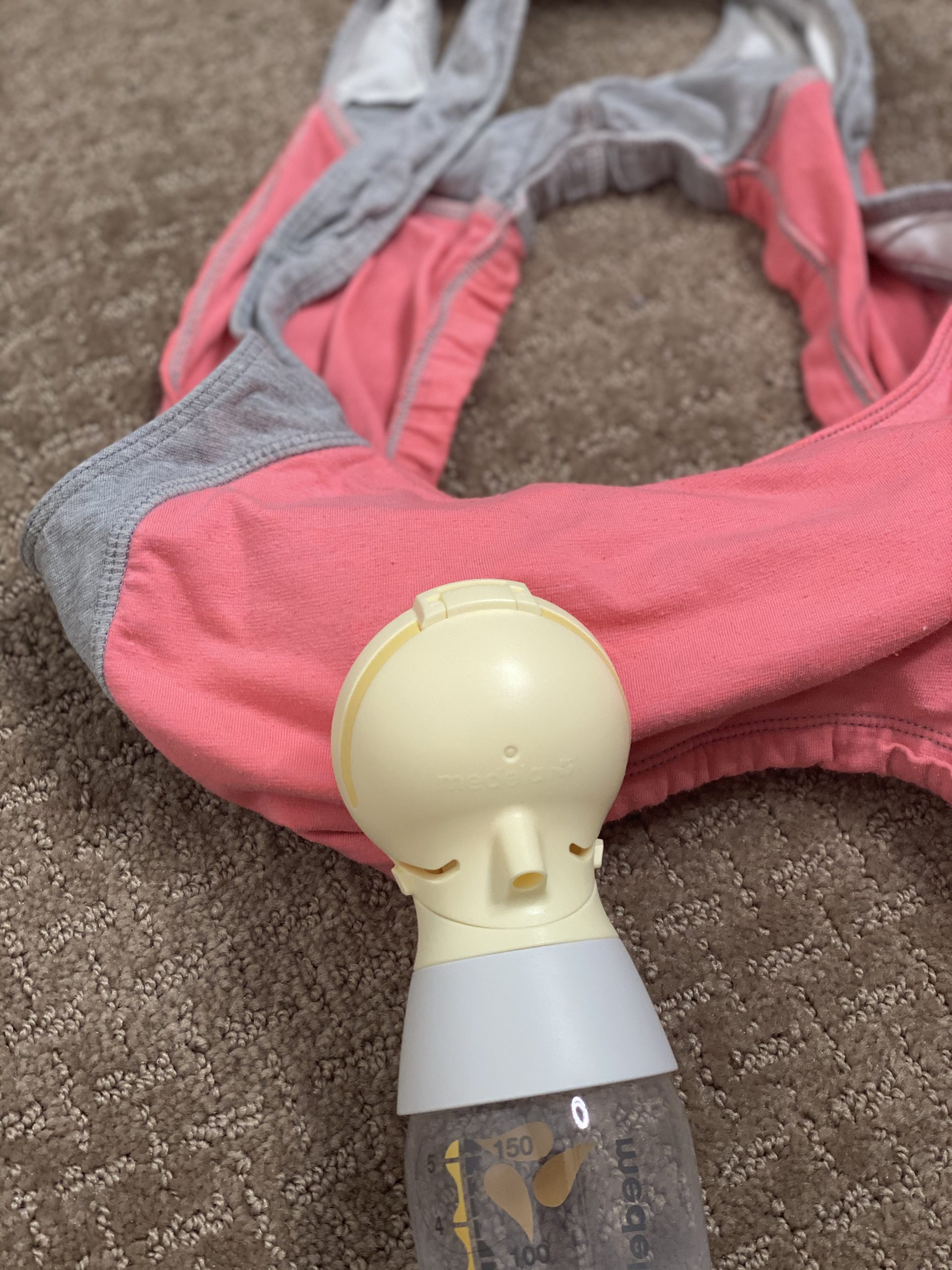Most breastfeeding mothers ask themselves at one time or another, “Am I producing enough milk?” Chances are – you are! But if you are in that boat, this post will answer all the questions you have about if you have low milk supply and how to increase milk production.
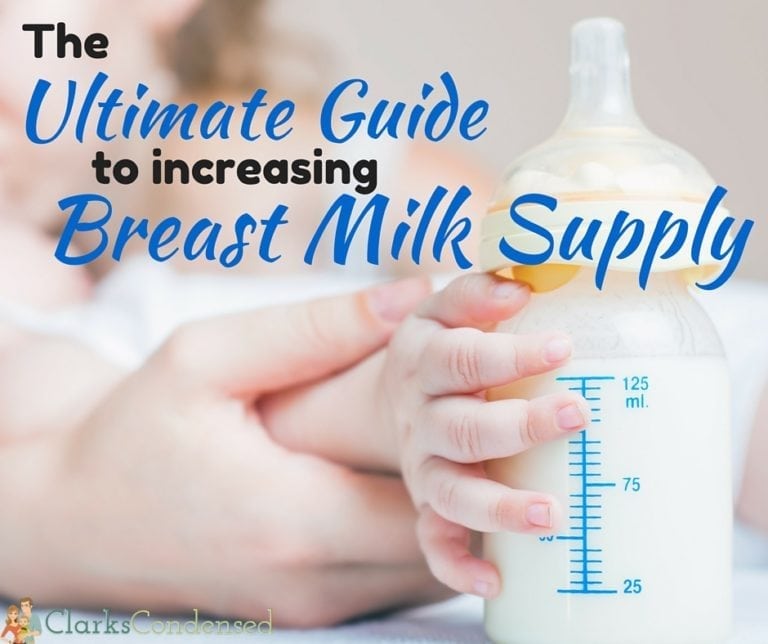
With Jack, I never worried about my milk supply.
I never wondered if he was getting enough or wished that there was some kind of ounce marker that I could refer to. To be honest, I didn’t even think worrying about breast milk was a “thing”. How to increase milk production was the last thing on my mind.
With Oliver, though, it has been a different story. I got mastitis within a week of giving birth, and it was disastrous. It was a horrible case that was combined with a very large plugged duct (there was a lump the size of a large kiwi along with a smaller one).
Combined with getting very little sleep, Oliver not gaining weight, and having to pump around the clock for awhile, my supply dwindled. However, I was determined to not let that prevent me from breastfeeding successfully, and I did everything I could to increase my supply. Fortunately, I was successful.
I am very grateful that I was able to find an excellent lactation consultant. She worked me with tirelessly to resolve issues I was having, and for that, I am forever grateful. Many doctor’s offices have some on staff, and you can also contact WIC or the La Leche League to find one. If you are struggling to increase milk production, make sure you are in touch with an IBCLC.
If you are interested in learning more about pumping and milk supply, be sure to check out our on demand, online class, “Demystifying Pumping and Breast Milk.” It’s just $19.99.
[the_ad id=”124153″]
It has so much information about pumping and milk supply! You may also want to consider “The Complete Online Breastfeeding Class“, which includes everything that can be found in the pumping class – plus everything else you need to successfully breastfeed.
The first few weeks of nursing is essential – it is setting up your supply for your entire breastfeeding experience. There’s a reason why they say not to supplement (if it’s not necessary) or introduce a bottle during the first 4-6 weeks – anytime away from the breast can impact your supply.
If you are finding yourself with a low milk supply hopefully some of these tips will help! First I’ll talk about why your supply is low (and what isn’t probably low supply), and then I’ll share a whole bunch of ways to help increase milk supply! This is a long one, but if you are like me – when you have a problem, you like to know everything.
This advice should NOT be taken in place of a professional. Also, if you struggle with low supply and you can’t/don’t want to try and increase it, that’s okay, too 🙂
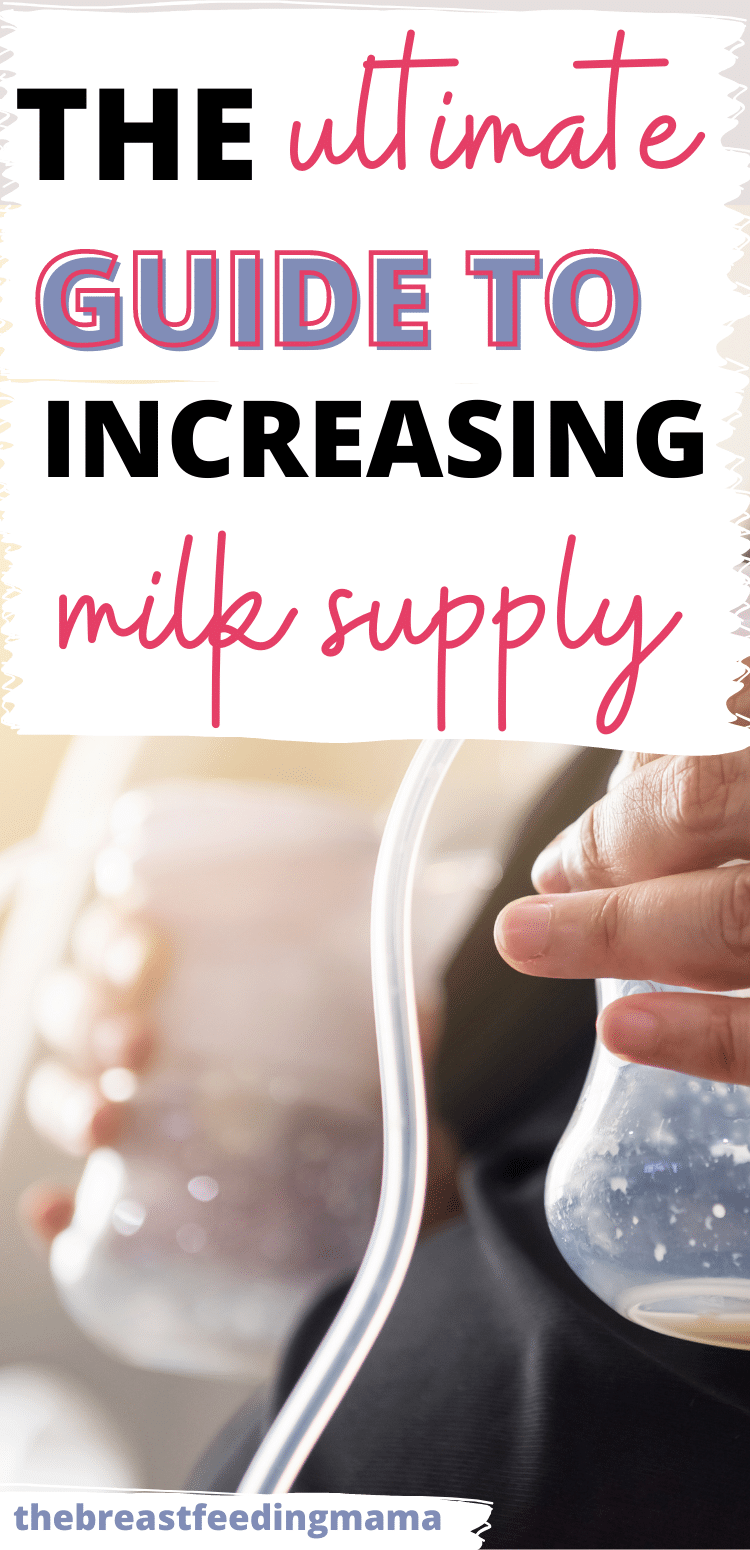
What Helps Milk Production
Why is My Milk Supply Low?
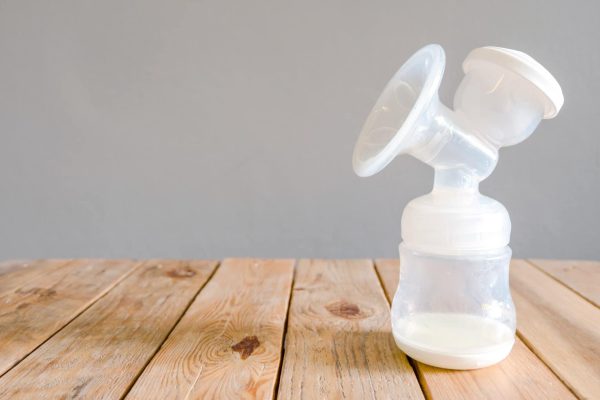
This is an essential question to ask when you are experiencing a lowered breastmilk supply. There are a lot of things that can impact supply – even just temporarily. Here are a few things to consider:
- Stress – this is a huge one. Stress, in and of itself, will not lower your milk supply. However, stress can distract you from nursing or pumping as much as you should, which can lower your milk supply.
- Lip/Tongue Tie – These can be controversial, but I know first hand the damage a tongue or lip to can cause. Check out Dr. Ghaheri’s website for more information, or join the Tongue Tie Babies Support Group on Facebook (especially to find a preferred provider). Great resources!
- Medications: There are certain medications that can and will interfere with milk supply – particularly anything that contains estrogen. Before you take a medication, I recommend checking to see if it’s known to lower milk supply. Antihistamines are also known for drying milk supply right up! The Mommy Med’s app is a great resource for all things breastmilk and medication-related, and you can always call the Infant Risk Hotline.
- Mastitis or Plugged Ducts: As I mentioned above, this was the cause of some of my low milk supply. If you have either of these issues, it’s important to keep nursing on that side (and if the pain is too unbearable, pump instead.) I LOVE this product to help with mastitis and plugged ducts. Be sure to read our article on this.
- Supplementing: There are cases were supplementing is necessary. However, it’s not recommended to do so if you don’t need to – especially in the first six weeks when your milk supply is regulating. If you need to supplement, read my notes below on how to do so without hurting your supply. Use breastmilk if you can to supplement, but, of course, feeding your baby is most important.
- Not feeding on demand: People are often quick to put their baby’s on a strict schedule. While it’s good to want to create a routine for your baby, it’s also important to listen to their cues. Babies are pretty intuitive. When they are hungry, they will let you know. When they nurse more, it’s just signaling to your body that it needs to produce more milk. I would avoid trying to get on any type of strict feeding schedule until after about six weeks.
- Pregnancy: Hormones can really mess with your milk supply – and if you get pregnant, there’s a chance your milk will dry up with it. Some women can nurse straight through pregnancy, and others do not. There’s really no way to know until it happens. From what I understand, you can’t really prevent it either. Your body will do what it wants!
- Nipple shields: I know there are mixed feelings on these, and that they do help people! However, they can decrease milk supply, so don’t use one unless you really need to, and wean from the shield as soon as you can. I have heard that the newer nipple shields are much better than ones in the past! You should always be working with a lactation consultant before using a nipple shield.
Did you just experience a drop suddenly? Be sure to read this post to figure out possible reasons why – Sudden Drop in Milk Supply? 15 Things That Might Be the Culprit.
[the_ad id=”124283″]
How Do I Know if My Milk Supply is Low?

Few women have true low milk supply (as in, it might be impossible to produce more than they are).
If you have been able to produce an adequate supply of milk before, you can more than likely produce it again.
Many women have even been able to re-lactate after stopping or not even nursing at all – you can even breastfeed when you adopt a child with the proper support.
There are some conditions that will cause low milk supply and those should be addressed with a physician or a lactation consultant.
This can occur with women who have had breast surgery (either for reduction/enhancement, cancer, lumps removed, etc.), did not develop adequate mammary glands, etc.
Breast size does not indicate a better or worse ability to produce milk.
I’m in several breastfeeding support groups, and it seems that at least every day, there is someone worried about supply. However, there are two questions you should ask yourself before you get too worried:
- Is my baby having enough wet/poopy diapers?
- Is my baby gaining weight well?
For a breastfed baby, they should have a minimum of four very wet diapers a day.
For the first six weeks, they should have several poopy diapers as well.
After six weeks, some breastfed babies will continue to have a lot of bowel movements, but it is very normal to go several days without one.
The laxative effect of breast milk starts to wear off at that point, and there is very little waste with breastmilk.
Breastfed babies typically gain 5-7 ounces a week for the first 4-6 months of life, and then weight gain slows. Make sure your doctor is using the WHO guidelines for your baby’s weight gain.
Here is some great information from Kelly Mom on the growth patterns of breastfed babies.
And, as my favorite article by Dr. Jay Gordon says, watch the baby, not the scale.
It’s hard because the breast doesn’t have ounce markers, so it can be tricky to know for sure how much your baby is getting. You can do weighted feeds (the Hatch Baby Grow is excellent for that).
What does not necessarily indicate a low supply?
- Baby wanting to feed frequently – this can be very, very normal, especially during a growth spurt or in the first few weeks of breastfeeding. Cluster feeding is normal! I highly recommend the Wonder Weeks app, as it can give you a good idea of when your baby is going through a mental leap (which may lead to more feeding and fussiness.)
- Increased fussiness – there are many reasons for fussiness (going through a growth spurt or a mental leap, colic or GERD, over-tiredness.) Babies tend to be fussier in the evening! Milk production tends to be less in the afternoon/early evening.
- Pump output – no pump will ever be as efficient as a baby. There are some women that NEVER respond to a pump, and they help grow nice, plump babies. If you are needing to pump a lot, be sure to check out my guide to pumping. But even if you see a decrease in output down the road, it doesn’t mean your supply is down (it more than likely means it has regulated.)
- Not feeling a letdown – I NEVER felt a let down with Jack. Not every woman will.
- Weighted Feeds – this is a common technique to check a baby’s breastmilk intake. However, when talking to the IBCLC I used to see, she told me that one weighted feed is not indicative of what a baby is taking in. If you really want to monitor intake, weighted feeds over the course of 24 hours is much more effective. It doesn’t necessarily matter how much a baby takes in at one feed, but the amount they take over the course of 24 hours (average intake is 24-30 ounces.) I love my Hatch Baby scale for doing weighted feeds at home.
What could indicate a low supply
- Baby not gaining weight: This is really one of the only signs I can think of that would indicate a possible low supply. I say possible because there are several reasons why a baby may not be gaining weight – latch, sleepiness, jaundice, etc. However, if your baby isn’t gaining weight, it’s certainly something to investigate.
- Baby is unsettled at the breast, constantly pulling away, or doesn’t want to nurse. This could also be indicative of a bottle preference.
Don’t forget to consider signing up for “The Complete Online Breastfeeding Class” to learn more about milk supply, pumping, and breastfeeding.
How to Increase Milk Production
Nurse, Nurse, Nurse
This is the BEST way to increase your milk supply. Nursing is a supply and demand system – the more you nurse, the more milk your body produces.
When I was researching tips on how to increase milk supply, I came across a post on Dr. Jay Gordon’s website. I started reading the comments, and the lactation consultant that was responding kept telling people that for the first six weeks of life, you should really be feeding your baby every 60-90 minutes, rather than the three hours that is often promoted in the hospital.
That might be a *little* much and not necessary for every baby, but if you are struggling with supply, do that! Often when I see people asking about supply in groups I’m in, they are not feeding frequently enough. Wake your newborn up if they are sleeping too long! I think that was one of my mistakes.
I started doing this, and it was truly the thing that increased my supply the most and caused Oliver to start gaining weight more quickly.
So even if supply isn’t necessarily an issue, if your child is having issues gaining weight, feeding smaller meals more often can help. Grab your boppy, buy a subscription to Netflix, and fill up your water cup – might as well make yourself comfortable!
Nursing vacation
Something else I read about is called a nursing vacation. Basically, for a day, just go in your room and feed your baby all day long. Don’t let anything distract you – just nurse all day long with plenty of water by your side.
Power Pumping
@thebfmama Power pumping! ##learnontiktok ##tiktokpartner ##newmomhacks ##newmomtips
♬ original sound – Katie Clark, CLE®
My lactation consultant recommended this quite a bit to people.
Basically, get comfortable for an hour with a TV Show or movie and pump. You pump on each side for 10 minutes, then take a break for 10 minutes, and continue this process for an hour. You can do this 1-2 times a day, and you should see an increase in supply in about three days.
I highly recommend buying, renting, or borrowing a high-quality pump. Your insurance should cover a breast pump (learn how to get a free breast pump here). My life was so much easier when I got a hospital grade double pump I had access to.
Insurance will often cover pumps nowadays, and WIC can sometimes loan one out as well. I’ve heard AMAZING things about the Spectra pumps. They are quite reasonable as far as price goes. I have the AVENT Double Electric Pump, and it seems to work well for me!
[thrive_lead_lock id=’30533′]Hidden Content[/thrive_lead_lock]
Pumping after supplementing
Sometimes. supplementing is necessary. If your baby truly isn’t getting enough, the most important thing is that they get fed! However, I highly recommend working with an IBCLC if you get a recommendation to supplement – or, at the very least, reading this great article.
I had to do this with Oliver – though I didn’t use formula. I just pumped every time after I fed him and then gave him whatever I had leftover about 30 minutes later.
If you do end up supplementing full feedings with either formula or pumped milk, it’s important to make sure you pump after that feeding.
Supplementing can decrease supply if you don’t pump after. The less time the baby is at the breast, the less your body is told to create. I’ve been told that supplementing is a slippery slope, so unless you really need to, avoid supplementing!
Be Close to your Baby
Being near your baby can help release prolactin, which increases milk supply. There are many reasons why skin to skin is so emphasized when it comes to breastfeeding (see Dr. Newman’s page on the importance of skin to skin.)
If you can, hold your baby as much as you can, do skin to skin, and just nearby. It may help them want to nurse more as well. Babywearing is an awesome thing you can do (I LOVE babywearing – here is a post I wrote about the basics of babywearing, along with some carrier recommendations).
It helps free up your hands so you don’t feel like you have to hold your baby all day, but it keeps them nice and close. Sleeping in the same room is helpful, tool.
Breast Compressions
This a method to help continue the flow of milk from the breast when the baby is not actively sucking. This isn’t something that most breastfeeding mothers need to do, but if you are struggling with supply, your baby isn’t eating well or gaining weight, or any number of reasons, you may want to look into this.
Here is more information from Dr. Jack Newman’s website on breast compressions.
Eat Enough Calories
It can be tempting to try and diet to get back to your pre-baby weight. While you should do your best to eat healthily and moderately exercise to do so, it’s so important to make sure you are eating enough calories.
Remember, breastfeeding can burn around 500-800 calories a day, so you want to make sure you are eating enough so you produce milk.
I know many women who have seen a big dip in milk supply when they’ve lost weight fast or started a really intense workout program. You should aim to lose about one pound per week. Here is a post I wrote about losing weight while breastfeeding without compromising your milk supply!
ANd if you are having trouble finding things to eat, here are the best snacks for breastfeeding moms.
Gatorade for Breast Milk Supply
Okay, I haven’t actually tried this one, but in my breastfeeding forums, Gatorade is a popular suggestion for increasing milk supply. I’m of the belief it’s more the hydration than anything, but if you think it works, go for it.
Another popular drink recommendation are Body Armour drinks.
Be careful, though, as these contain a lot of sugar!
Lactation Smoothie
You could make a smoothie with lots of healthy ingredients and healthy fats, as well as throw in some flax seed. Or you could buy this lactation smoothie mix. It has GREAT reviews!
Dark Beer
I was hesitant to put this one, because I do not drink myself. However, I’ve heard from many sources that drinking a dark beer can increase milk supply temporarily.
You can drink alcohol while breastfeeding (I think the general rule is if it’s safe to drive, it’s safe to nurse), but drink responsibly if you choose to do so. Here is more information on breastfeeding and alcohol from Kelly Mom.
Rest/Destress
It may seem impossible to get enough sleep when you have a breastfeeding baby, but it’s important to rest as much as you can.
Being tired and stressed out can definitely decrease your supply. My lactation consultant recommended that I go and get a massage! I didn’t, but I feel like it definitely would have helped. And seriously, worrying about your milk supply will just make things worse.
Water
Just make sure you stay hydrated! With both of my boys, I was given a huge water cup to take home. I make sure I drink at least two or three of those a day. If you have trouble consuming a lot of water, an infused water bottle can be really helpful.
Personally, I have had a lot of luck with getting a 64-ounce water bottle to help make sure I drink enough.
If you don’t like plain water, I really like these True Lemon packets. The orange ones sound great, too!
Lactation Cookies
Lactation cookies are pretty popular. There are a ton of different places to buy them as well as recipes out there. In general, they typically have Brewer’s Yeast, flax seed, and oats (preferably steel cut oats), along with some other ingredients to make them taste good. I really love my recipe for dairy free lactation cookies, and I felt they helped me a lot.
Oatmeal
I have a bowl of oatmeal every morning, and not only is it healthy, but it can help with milk supply! I have been LOVING Coach’s Oats lately. I’ve tried a lot of different oats, and this is definitely my favorite.
Hypnosis
Okay, I know this might sound a bit weird, but I listened to this YouTube hypnosis video one night when I was worried about milk supply, and it worked! Hypnobabies has a track called “Breastfeeding Success” that I’ve heard great things about as well. Just go to their website and type in breastfeeding success, and it should show up.
Goat’s Rue
This is an herb that stimulates the development of mammary tissue. I’ve heard great things about it!
Mother’s Milk Teas
I’ve heard mixed reviews about mother’s milk teas. I personally never tried them, nor do I think they are the best option. But they might be worth looking into if you are drinking tea anyways.
Alfalfa
This is a less common thing I’ve heard, but I know many people that swear by Alfalfa. It is very nutritious and safe for breastfeeding. I read that too much of it can cause diarrhea.
Here is some more information. It’s thought to help prevent excessive bleeding (such as hemorrhaging) so it can be helpful after giving birth to help control bleeding as well.
Avoid peppermint and sage
These are two things that are known to lower breastmilk supply. Some people will say you have to eat them in copious amounts, but I think that
Fenugreek + Milk Thistle + Fennell
I think Fenugreek is something that a lot of women first jump to when they have supply worries or issues. It really shouldn’t be, as there are many things (listed above) you can do before that. However, it can be a successful thing in helping with milk supply.
Be warned, though – there are many women who see a decrease in supply when using Fenugreek.
I honestly did use Fenugreek when Oliver wasn’t gaining weight, because I was feeling so desperate.
I do think it helped, but I really don’t know. However, it can make you smell like maple syrup, have a lot of gas (or your baby), and there are certain people who should not use it (particularly diabetics.)
I felt really light headed a lot when I used it. Here is the suggested dosage charge from Kelly Mom.
It can be used in conjunction with Milk Thistle, and some recommend using Fennel as well, as that can help with any digestive disturbance.
There are a lot of products out there that are created to help lactating women, and they often feature these ingredients. Motherlove is a very popular one.
A Fenugreek free lactation supplement is called Legendairy Milk. I know a lot of people like this.
Just be careful with supplements. In most situations, you do not need one.
Prescriptions
I put this one last because it should only be used as a last resort. There are certain medications that can be used to increase milk supply. One that is often used is called Reglan.
However, I had the WORST reaction to Reglan when I was in the ER once, and the nurse said that the reaction I had was common. So I would be very careful with this one. There are many cited side effects for this one.
There is something called Domperidone. It is commonly used for digestive problems, but one of the side effects is increasing prolactin production.
You can read more about it on Dr. Newman’s website (breastfeeding expert.) In the United States, it isn’t prescribed, so most women that use it order it online from Canada or another country.
However, I would not just order it – consult with an IBCLC for the correct dosage and best place to buy it, as well as talk with your doctor. I’ve heard very wonderful things about Domperidone, but once again, any medication should be used as a last resort.
originally published in 2016; updated in 2019.
Other Breastfeeding Posts You May Enjoy:
- 80+ of the Best Breastfeeding Snacks (That Won’t Leave You Feeling Gross)
- Sudden Drop in Milk Supply? 15 Things That Might Be the Culprit.
- 25+ of the Best Breast Pumping Tips: Must Read for New Moms
